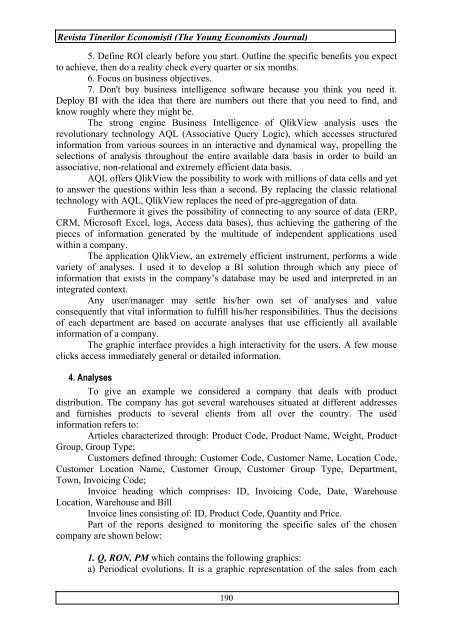Revista Tinerilor Economiºti (The Young Economists Journal)
Revista Tinerilor Economiºti (The Young Economists Journal)
Revista Tinerilor Economiºti (The Young Economists Journal)
You also want an ePaper? Increase the reach of your titles
YUMPU automatically turns print PDFs into web optimized ePapers that Google loves.
<strong>Revista</strong> <strong>Tinerilor</strong> Economişti (<strong>The</strong> <strong>Young</strong> <strong>Economists</strong> <strong>Journal</strong>)<br />
5. Define ROI clearly before you start. Outline the specific benefits you expect<br />
to achieve, then do a reality check every quarter or six months.<br />
6. Focus on business objectives.<br />
7. Don't buy business intelligence software because you think you need it.<br />
Deploy BI with the idea that there are numbers out there that you need to find, and<br />
know roughly where they might be.<br />
<strong>The</strong> strong engine Business Intelligence of QlikView analysis uses the<br />
revolutionary technology AQL (Associative Query Logic), which accesses structured<br />
information from various sources in an interactive and dynamical way, propelling the<br />
selections of analysis throughout the entire available data basis in order to build an<br />
associative, non-relational and extremely efficient data basis.<br />
AQL offers QlikView the possibility to work with millions of data cells and yet<br />
to answer the questions within less than a second. By replacing the classic relational<br />
technology with AQL, QlikView replaces the need of pre-aggregation of data.<br />
Furthermore it gives the possibility of connecting to any source of data (ERP,<br />
CRM, Microsoft Excel, logs, Access data bases), thus achieving the gathering of the<br />
pieces of information generated by the multitude of independent applications used<br />
within a company.<br />
<strong>The</strong> application QlikView, an extremely efficient instrument, performs a wide<br />
variety of analyses. I used it to develop a BI solution through which any piece of<br />
information that exists in the company’s database may be used and interpreted in an<br />
integrated context.<br />
Any user/manager may settle his/her own set of analyses and value<br />
consequently that vital information to fulfill his/her responsibilities. Thus the decisions<br />
of each department are based on accurate analyses that use efficiently all available<br />
information of a company.<br />
<strong>The</strong> graphic interface provides a high interactivity for the users. A few mouse<br />
clicks access immediately general or detailed information.<br />
4. Analyses<br />
To give an example we considered a company that deals with product<br />
distribution. <strong>The</strong> company has got several warehouses situated at different addresses<br />
and furnishes products to several clients from all over the country. <strong>The</strong> used<br />
information refers to:<br />
Articles characterized through: Product Code, Product Name, Weight, Product<br />
Group, Group Type;<br />
Customers defined through: Customer Code, Customer Name, Location Code,<br />
Customer Location Name, Customer Group, Customer Group Type, Department,<br />
Town, Invoicing Code;<br />
Invoice heading which comprises: ID, Invoicing Code, Date, Warehouse<br />
Location, Warehouse and Bill<br />
Invoice lines consisting of: ID, Product Code, Quantity and Price.<br />
Part of the reports designed to monitoring the specific sales of the chosen<br />
company are shown below:<br />
1. Q, RON, PM which contains the following graphics:<br />
a) Periodical evolutions. It is a graphic representation of the sales from each<br />
190















